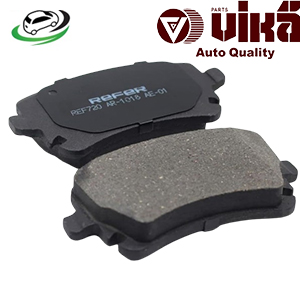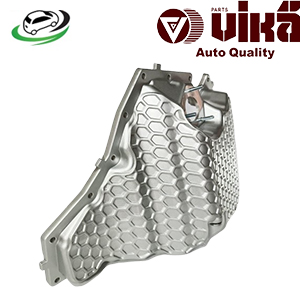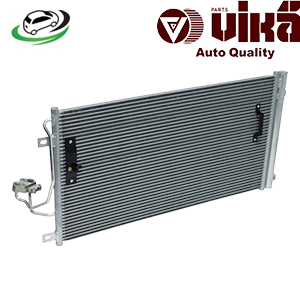-9%
Get VW Touareg 3.0L 3.2L 3.6L TDI V6/ Touareg 4.2L V8/ Touareg 4.9L V10/ Touareg 5.0L V10 Air Conditioning Condenser 7L0820411G
The air conditioning condenser is a crucial component of a vehicle’s climate control system, playing a vital role in maintaining comfortable cabin temperatures. Understanding its function, components, types, installation procedures, and maintenance practices is essential for vehicle owners and automotive enthusiasts. This comprehensive guide will explore these aspects, providing a thorough overview of the air conditioning condenser.
What is an Air Conditioning Condenser?
The air conditioning condenser is a heat exchanger that converts refrigerant vapor into a liquid state by dissipating heat absorbed from the vehicle’s cabin to the outside environment. It is typically located at the front of the vehicle, near the radiator, where it can take advantage of airflow while the vehicle is in motion. The condenser works in conjunction with other components of the air conditioning system, including the compressor, evaporator, and expansion valve.
Functions of the Air Conditioning Condenser
1. Heat Dissipation
The primary function of the condenser is to release heat from the refrigerant. When refrigerant enters the condenser as a high-pressure gas, it must release its heat to become a liquid. As air flows over the condenser coils, the heat is expelled, allowing the refrigerant to condense into a high-pressure liquid.
2. Pressure Regulation
The condenser plays a crucial role in maintaining the pressure within the air conditioning system. By converting gas to liquid, it helps regulate the system’s pressure, ensuring optimal performance of the air conditioning system.
3. Cooling Efficiency
By effectively dissipating heat, the condenser helps improve the cooling efficiency of the air conditioning system. A well-functioning condenser ensures that the refrigerant is adequately cooled before it returns to the evaporator, enhancing overall system performance.
4. System Protection
The condenser also protects the air conditioning system from damage. By regulating pressure and temperature, it prevents excessive strain on the compressor and other components, prolonging the lifespan of the entire system.
Components of the Air Conditioning Condenser
The air conditioning condenser consists of several key components that work together to facilitate heat exchange:
1. Coils
The condenser coils are made of metal (usually aluminum or copper) and are responsible for transferring heat from the refrigerant to the outside air. The coils are designed to maximize surface area, allowing for efficient heat dissipation.
2. Fins
Fins are attached to the coils to increase the surface area even further. They enhance airflow around the coils, improving heat transfer efficiency. The more fins present, the better the condenser can dissipate heat.
3. Inlet and Outlet Connections
These connections allow the refrigerant to enter and exit the condenser. The inlet is where the high-pressure gas enters, while the outlet is where the high-pressure liquid leaves to enter the expansion valve.
4. Receiver-Drier (or Accumulator)
Some condensers are equipped with a receiver-drier or accumulator, which helps filter impurities from the refrigerant and removes moisture. This component is crucial for preventing damage to the system caused by contaminants or moisture.
5. Mounting Brackets
Mounting brackets secure the condenser to the vehicle’s frame, ensuring it remains stable and properly positioned for optimal airflow.
Types of Air Conditioning Condensers
There are several types of air conditioning condensers, each with its design and application:
1. Bar and Plate Condenser
Bar and plate condensers consist of a series of parallel plates separated by bars. This design provides excellent heat exchange efficiency and is commonly used in high-performance applications due to its lightweight and compact nature.
2. Tube and Fin Condenser
This type features tubes that carry the refrigerant, surrounded by fins that increase the surface area for heat dissipation. Tube and fin condensers are widely used in automotive applications due to their cost-effectiveness and reliability.
3. Serpentine Condenser
Serpentine condensers have a continuous flow design, allowing refrigerant to travel through a series of loops. This design enhances heat transfer efficiency and is commonly found in modern vehicles.
4. Microchannel Condenser
Microchannel condensers utilize small channels to facilitate refrigerant flow. They are lightweight, compact, and provide high heat exchange efficiency. Microchannel technology is increasingly used in automotive air conditioning systems for its performance benefits.
Installation of the Air Conditioning Condenser
Installing a new air conditioning condenser requires a certain level of mechanical knowledge and the right tools. Here’s a step-by-step guide to help you through the process:
Tools and Materials Needed:
- New air conditioning condenser
- Refrigerant recovery machine
- Wrench set
- Screwdriver set
- Pliers
- Safety goggles and gloves
- Torque wrench
- Replacement O-rings
Installation Steps:
- Safety Precautions: Ensure the vehicle is parked on a flat surface, and engage the parking brake. Wear safety goggles and gloves for protection.
- Recover Refrigerant: Use a refrigerant recovery machine to safely recover the refrigerant from the air conditioning system. This step is essential to avoid releasing harmful substances into the environment.
- Remove the Front Bumper (if necessary): Depending on the vehicle model, you may need to remove the front bumper to access the condenser. Follow the manufacturer’s instructions for this process.
- Disconnect the Old Condenser: Locate the condenser and disconnect the inlet and outlet lines. Use pliers to remove the retaining clips, if applicable, and be prepared for any residual refrigerant that may escape.
- Remove Mounting Bolts: Unscrew the bolts or screws securing the condenser to the vehicle’s frame. Carefully lift the old condenser out of the mounting brackets and set it aside.
- Prepare the New Condenser: Before installing the new condenser, ensure that the O-rings on the inlet and outlet connections are in good condition. If they appear worn or damaged, replace them with new ones to prevent refrigerant leaks.
- Install the New Condenser: Position the new condenser in the mounting brackets and secure it with the bolts or screws. Ensure it is properly aligned for optimal airflow.
- Reconnect the Refrigerant Lines: Reattach the inlet and outlet lines to the new condenser. Make sure the connections are tight, and the O-rings are properly seated to prevent leaks.
- Reinstall the Front Bumper (if removed): If you had to remove the front bumper, reinstall it according to the manufacturer’s instructions.
- Evacuate and Recharge the System: Use a vacuum pump to evacuate the air and moisture from the air conditioning system. Once evacuated, recharge the system with the appropriate type and amount of refrigerant as specified by the manufacturer.
- Test the System: Start the vehicle and turn on the air conditioning. Monitor the system for any unusual noises, leaks, or poor performance. Ensure that the air conditioning is blowing cold air and functioning correctly.
Maintenance of the Air Conditioning Condenser
Regular maintenance of the air conditioning condenser is essential for optimal performance and longevity. Here are some maintenance tips:
1. Visual Inspections:
Periodically inspect the condenser for signs of damage, such as bent fins, leaks, or corrosion. Address any issues promptly to prevent further damage.
2. Clean the Condenser:
Remove dirt, debris, and contaminants that may accumulate on the condenser’s surface. Use compressed air or a soft brush to clean the fins and coils carefully.
3. Check for Leaks:
Regularly check the refrigerant lines and connections for leaks. If you notice a drop in cooling performance or detect refrigerant odors, have the system inspected.
4. Monitor System Performance:
Keep an eye on the air conditioning system’s performance. If you notice unusual noises, reduced cooling efficiency, or erratic behavior, have the system checked by a professional.
5. Professional Maintenance:
Consider scheduling regular maintenance with a qualified technician. They can perform a thorough inspection, recharge the refrigerant, and address any potential issues before they become major problems.
Signs of a Failing Air Conditioning Condenser
Recognizing the signs of a failing air conditioning condenser is crucial for timely intervention. Common symptoms include:
- Reduced Cooling Efficiency: If the air conditioning system struggles to cool the cabin, it could indicate a problem with the condenser. Insufficient heat dissipation can lead to poor cooling performance.
- Visible Leaks: Any visible signs of refrigerant leakage around the condenser or connections should be addressed immediately. Refrigerant leaks can lead to a complete loss of cooling ability.
- Unusual Noises: Hissing, rattling, or grinding noises coming from the air conditioning system may indicate a failing condenser or other components. These sounds should not be ignored.
- Increased Engine Temperature: A malfunctioning condenser can cause excessive heat buildup, potentially leading to an increase in engine temperature. This situation can affect overall vehicle performance.
- Foul Odors: Unpleasant odors coming from the air conditioning system can indicate mold or mildew growth, which may be exacerbated by a failing condenser.
Conclusion
The air conditioning condenser is a vital component of a vehicle’s climate control system, ensuring effective cooling and comfort for occupants. Understanding its functions, components, types, installation procedures, and maintenance practices is essential for vehicle owners. By prioritizing the care and maintenance of the condenser, drivers can enhance the performance and longevity of their air conditioning systems, ensuring a comfortable and enjoyable driving experience. Regular inspections, timely replacements, and professional maintenance will contribute to a more efficient and reliable vehicle climate control system.
Follow us on Facebook for more parts.




Reviews
Clear filtersThere are no reviews yet.